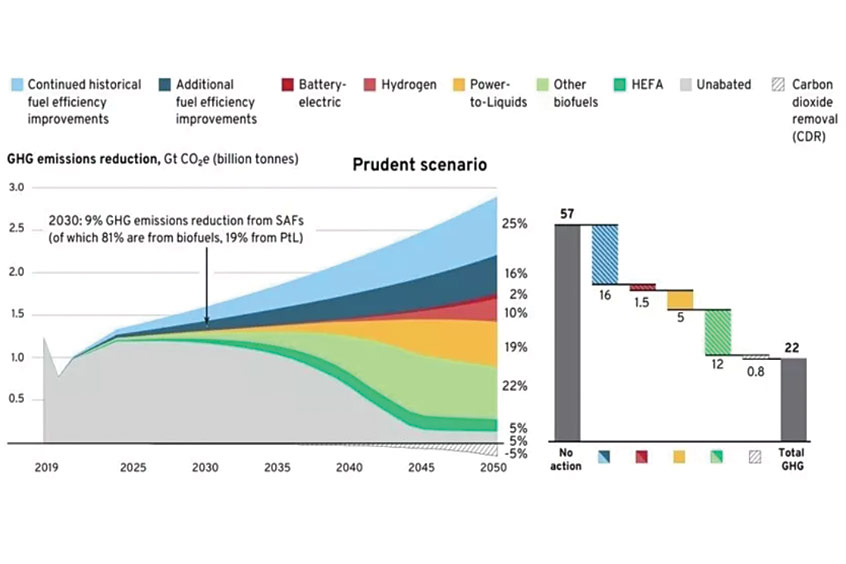ACE 2026 - The home of global charter.
 The bimonthly news publication for aviation professionals.
The bimonthly news publication for aviation professionals.

This summer saw the return of the Paris Air Show after its four year pandemic-induced closure, and decarbonisation was at the heart of many business air travel discussions. Carbon Offset Certification is collaborating with a growing number of air charter operators looking to propose credible and robust green aviation services to their clients. This complex initiative comes at a time when public and regulatory scrutiny is growing. Director Paul Sébastien and relationship manager Thiago Machado discuss the opportunities for verifiable green marketing solutions versus greenwashing:
The business aviation industry is facing a strong shift toward green solutions as a response not only to growing regulation but also to passenger demand and accountability for climate-positive action. It falls under the spotlight as carbon emissions from one passenger on a private jet can be up to 40 times greater than those from a passenger on a commercial flight. So companies are setting Paris Agreement-aligned Net Zero strategies that follow carbon mitigation hierarchy principles, where decarbonisation efforts first prioritise GHG Avoidance and Reduction solutions, and then offset residual emissions. Avoidance/reduction means fleet renewal, cleaner propulsion and fuel efficiency technologies in the form of SAF, hydrogen and electric alternatives. Offsetting requires the purchase of carbon credits that either avoid or remove GHG emissions to compensate for hard-to-abate emissions.
According to ICAO, the path to zero emissions for the aviation sector requires a combination of solutions where new propulsion and fuel technologies could and should play a major role. Now it is a matter of scaling them.
SAF offers a significant and attractive opportunity for reducing emissions with minimal changes to current technology, but several challenges must be faced. One of the biggest is its cost, currently more than twice as much as conventional jet fuel, and another is the limited potential for scalability.
“Right now, the cost of sustainable aviation fuel on its own, without any incentives, would be maybe four or five times that of existing petroleum fuels and that's not sustainable for the industry,” says Valerie Reed, director of the bioenergy technologies office at the Department of Energy’s Office.
There is demand for SAF, but even if all the world's feedstock were allocated to produce it, production would fall way short of the total amount needed. So carbon offsetting is the best response to today’s demand for ‘green’ solutions. "Carbon credits are a proven tool for immediately reducing emissions, while also pursuing longer-term decarbonisation ambitions,” says Conservation International CEO M Sanjayan. Reducing emissions is the priority on the journey to Net-Zero, but offsetting is essential to mitigate residual emissions.
But business aviation is a business with a profit-oriented strategy, so to gain market share in the growing low-carbon aviation market means charging a green premium, where such 'greenium' can include an additional commercial margin on top of the cost to offset carbon footprint. For example, a Bombardier Challenger 350 or a Gulfstream G650 emit 3.3 tCO2e and 5.4 tCO2e per flight hour respectively.
The good news is that carbon offsetting remains, for now, quite inexpensive at below $10.tCO2e for quality certified carbon credits compliant with the CORSIA framework. So aside from mitigating the regulatory crackdown and enhancing brand reputation, it offers an affordable business development opportunity.
So how to avoid greenwashing? Some environmental communications can be hazy or even misleading and could jeopardise not only corporate reputations but also incur financial consequences, from fines to the confiscation of products and associated revenues. Stricter regulations, such as the European Union Greenwashing Directive, will ban misleading environmental claims such as ‘eco-friendly’, ‘green’ or ‘carbon neutral'. Communicating about 'carbon neutral' products where their carbon footprint is offset (even after a significant GHG reduction effort) is already considered to be greenwashing. To avoid criticism and backlash, companies should put robust and credible communication at the core of their sustainability initiatives. It's not just about what you claim, it is more about what you can prove. And in the EU at least, any green communication will need to prove its green claims through third-party verification and certification bodies.
There is no question that stricter green regulations are here to stay, so credible justification is essential. Independent certification labels such as Switzerland-based certification standard Carbon Offset Certification, developed in partnership with the aviation industry and the global verification body Bureau Veritas, offer best-in-class methodologies and market consensus to ensure that green claims are what they claim to be.
Certifying claims for carbon offset products or services with consistent publicly available certification protocol aligned with best standards for GHG accounting and offsetting practices is essential if companies want to avoid reputational and financial risk. Credible and justified green products and services should address reputational, regulatory and financial risks while driving strong business momentum.